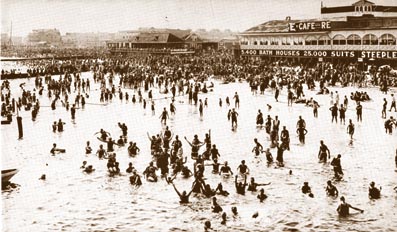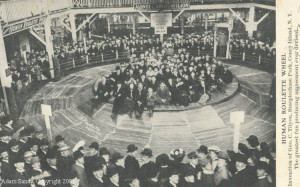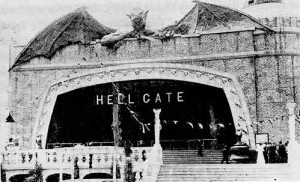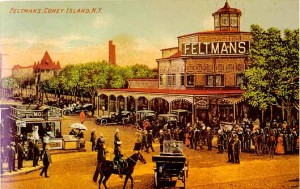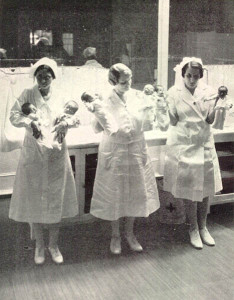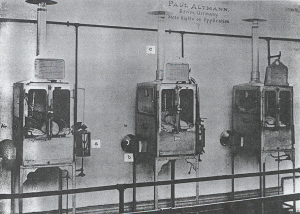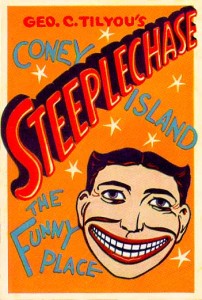The Coney Island that greeted vacationers and city folk in the years 1904 to 1911 was one of infinite imagination manifested in fantastic but cheaply built extravaganza.
A world of amusement starts here in New York — Coney Island, the world’s oldest and strangest collection of amusement parks, a mishmash of sideshows, concession stands, gambling halls, new-fangled rides and luxury hotels. Take a daytrip with us back to the early days of Coney Island. Hold on to your hat!
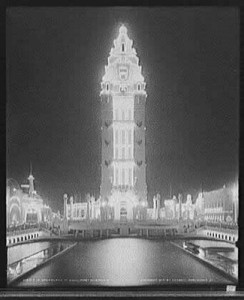 Part of what made the experience of Coney Island’s cheap, often disposable thrills was its meshing of new technology, human invention, and reactions to a strict moral society. It was socially acceptable debauchery, literally plugged in to the experience of a new century. The advent of electricity brought visitors out into the salty air until late at night. Benches were often sent slight electrical charges to make sure people didn’t sit around all day, not spending money! With electricity used more aestheticly as it was in Luna Park (right), they could light up the sky like Oz. The name Luna Park paid homage to A Trip To The Moon, a ride created by its parks owners Frederick Thompson and Elmer “Skip” Dundy, which in turn was certainly a close approximation of the French 1902 silent film classic by Georges Méliès.
Part of what made the experience of Coney Island’s cheap, often disposable thrills was its meshing of new technology, human invention, and reactions to a strict moral society. It was socially acceptable debauchery, literally plugged in to the experience of a new century. The advent of electricity brought visitors out into the salty air until late at night. Benches were often sent slight electrical charges to make sure people didn’t sit around all day, not spending money! With electricity used more aestheticly as it was in Luna Park (right), they could light up the sky like Oz. The name Luna Park paid homage to A Trip To The Moon, a ride created by its parks owners Frederick Thompson and Elmer “Skip” Dundy, which in turn was certainly a close approximation of the French 1902 silent film classic by Georges Méliès.
Over at Steeplechase Park, meanwhile, it was more centrifugal and gravitational forces that brought out the crowds, such as the Human Roulette wheel below. I dont know, there’s just something about this that looks profoundly unfun to me:
One of the more unusual amusements at Dreamland was Hell’s Gate, which emulated via the guise of starched Victorian morality the possible geography of Biblical Hell. Perhaps unsurpring, it was the combination of a burst lightbulb and a tar bucket inside Hell’s Gate that started the fire that eventually burned all of Dreamland to the ground in 1911, burning for 18 hours.
The proper entrepreneur who could maneuver through the early days of Coney Island corruption and make a financial killing. Take the inventer of the hot dog, Charles Feltman, who launched restaurants and hotels from the success of his sausage in a roll carts. This fancy restaurant, a favorite of vacationers of all social classes, sat where modern Astroland sits today:
(Not to spoil anything from our next episode, but in 1915, an employee of Feltman’s Restaurant Nathan Handwerker ate free hot dogs all summer, then devised an idea….)
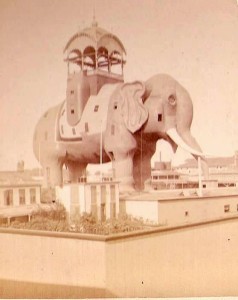 Why stay in a luxury hotel when you can just sleep in a giant elephant? This unusual lodging was built in 1882, just a few steps from the world’s first roller coaster, the Switchback Railway, and you could view the beach revelers via windows that served as the elephant’s eyes. One leg featured a small cigar store, while the back legs had a staircase that led to your room. Perhaps because this doesnt exactly look like the most comfortable revolution in hospitality, the hotel soon became a favorite for prostitues, so that ‘seeing the elephant’ soon became a rather naughty euphemism. Our shabby pachyderm was mercifully put out of its misery in 1896 by fire. I love this aerial view of the area, with the Elephant lording clumsily over the landscape, well before the Island’s peak days a few years later.
Why stay in a luxury hotel when you can just sleep in a giant elephant? This unusual lodging was built in 1882, just a few steps from the world’s first roller coaster, the Switchback Railway, and you could view the beach revelers via windows that served as the elephant’s eyes. One leg featured a small cigar store, while the back legs had a staircase that led to your room. Perhaps because this doesnt exactly look like the most comfortable revolution in hospitality, the hotel soon became a favorite for prostitues, so that ‘seeing the elephant’ soon became a rather naughty euphemism. Our shabby pachyderm was mercifully put out of its misery in 1896 by fire. I love this aerial view of the area, with the Elephant lording clumsily over the landscape, well before the Island’s peak days a few years later. 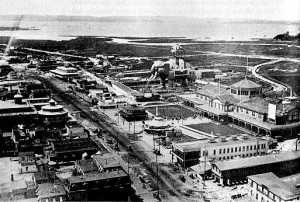
Elephants in general didnt fare so well in Coney Island. Then there’s the case of Topsy, the once friendly elephant at Luna Park who went wild and killed three men. Her owners decided to put her down, attempting to poison her with cyanide-laced carrots, to no avail.
Enter Thomas Edison, who was trying to prove the dangers of his rival George Westinghouse’s alternating electrical current to his own ‘safe’ direct current. He did this by going around the country and electricuting dogs and cats as a demonstration. So when he heard that the owners of Luna were trying to off their elephant, he couldnt refuse.
They even made the ‘demonstration’ the topic of a silent film, which you can see here.
By the way, there are so many resources online about early Coney Island history, that I invite you to check a few of these wonderful places out yourself:
Coney Island History Project
Amusement Parks history
Coney Island History Site
And in case you don’t believe me about that sideshow exhibit involving premie babies in incubators, here’s a shot of some of the nurses displaying the stars of the show, followed by a look at the actual incubators. The exhibit actually ran for decades in Coney Island, until 1945. You know, because there’s nothing more entertaining than watching a newborn infant struggling to survive:

